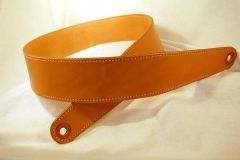-
Posts
2,397 -
Joined
-
Last visited
Content Type
Profiles
Forums
Events
Blogs
Gallery
Everything posted by Cyberthrasher
-
Have you seen tutorials on wet molding a pouch? Basically just like that. Form the gusset around something so that the portions that need to be stitched are held in shape after it's formed.
-
The easiest way to do that will be to wet form it in the shape that you need and get the sides flattened out. Other than that, the other option would be to glue them in place first so they're not trying to spring back on you while you stitch. But, wet molded will look a lot better. It also looks like maybe you're trying to stitch too far in. The distance from the edge should be about equivalent to the thickness of the two pieces combined (within reason).
-
For inside curves you'll want to use a hole punch and then finish it off with an X-acto/craft knife. For outside curves, just cut off straight pieces bit by bit until it's curved.
-
A lot of it is practice and practice, but you have to practice right. Don't just keep doing the same things the same way and hope for better results. It will never happen that way. The key is to LOOK at what you're doing VS. what's commonly referred to as high end and find the differences to see what needs to be addressed. WHY doesn't your work look like that? Is it depth of cut, flow of cut, consistency of tooling, etc.... You can cut lines all day, but if you don't know WHY the last one wasn't quite right, you won't know how to fix it. For the basic, I highly recommend Paul Burnett's "realistic leather carving" available at the PaintingCow website. Stohlman did a good job, but I don't feel he addressed a lot of the intricacies required for good clean control. A lot of it is left up to you to discover. But, Paul's work actually walks through a lot of those necessary basics and exercises in knife and tool control. One of my favorite exercises to recommend to people is one learned in pinstriping (and also covered in Paul's writings). Grab some scrap and cut several consecutive straight lines, focusing on making each line straighter and better than the last. Then do the same with "C" curves pointing both directions, then "S" curves. Do this every day. Then work on varying the depth of the cut while you're doing it. You'll be amazed at how much better you get. But, it will only work if you honestly stop and "overanalyze" the results with each cut.
-
I've seen talk of people using them, but never any mention of cleaning them. I would try acetone first. That will clean a lot of stuff. Also break cleaner could work quite well.
-
Remember back when you had to talk to people on the phone (or god forbid in person) and you couldn't go back and change what you said? At that time, so long ago, we had to add to our statement and say "this is what I meant"........not sure why that doesn't work on a forum. Or, how about your typos/mis-spoken words in email? What email client let's you go back and edit an email after it's been sent? Seems to me that the ability to edit your forum posts after the fact is a luxury that isn't really all that common in life.
-
More basic straps made from the low grade "Craftsman" Hermann Oak. I ran a sale to get rid of it because it really doesn't retain moisture well enough to tool, and it sucks up dye so quick you can't really get even coverage that easily. But, all the customers are happy and that side is just about gone, so I'd say my sale was a success!!!
-
Electrathon - think about it. If we were able to edit our own posts indefinitely, the OP could have already gone back, re-written everything he said and made it sound like he wasn't an arrogant fool to begin with. I do think it would be nice to have a little more time to edit, but it's also our responsibility to proof what we type. I've already stopped 3 times while typing this to make sure that what I was saying was what I meant to say.
-
You missed it. There's been several break downs over the past few months. But, they have gotten a little buried since I had to go search for them. If you search for "dying leather" you'll get all kinds of answers. Here's one where a step by step list was created. Try things out and figure out what works best for you. http://leatherworker.net/forum/index.php?showtopic=48166&hl=+dying%20+leather#entry305331
-

Is There A Way To Tell If This Is Veg Tanned?
Cyberthrasher replied to captain's topic in Getting Started
Then I'd say we can be pretty positive it is. Are you planning on tooling it? If so, find a discrete spot make a small mark with a tool, even a modeler. Then let it dry and see how well that spot holds -
I wouldn't worry so much about getting a sewing machine just yet. They're pretty spendy and you'll be a lot better off if you learn how to sew by hand first. It's important to understand stitching and then you can build your way up to a machine later. Tandy has a digital library where you can buy PDF copies of books. Since you're going to have trouble with shipping, that would be a good suggestion on where to start learning, aside from reading everything you can here.
-

Is There A Way To Tell If This Is Veg Tanned?
Cyberthrasher replied to captain's topic in Getting Started
I'm pretty sure it is. One easy method would be to see how it accepts water. Put a damp sponge along the cut edge and see if it sucks it in and distributes it. Not a lot of water, but enough that you can tell if it's pulling it in or not. -
here's a good tutorial that will show you what people are talking about with three layers. What you're looking for is a welt. Using that method, the stitching will be through the center strip (welt) and would never ever come in contact with the blade. http://www.knifenetwork.com/forum/showthread.php?t=41280
-
One thing I pulled from your rant is that your customers seem to have been expecting manufactured results instead of that variances that come with a handmade organic product. I'm not saying you're wrong in your frustration on consistency, but it's also important to educate our customers on the facts of custom leather. No two pieces will ever be the same and there are no guarantees. If I ever had a customer tell me I HAD to color match an item they already had, I would say "I can try to come as close as possible, but exact matching would be pretty hard to come by". Usually if it's worded right, they understand. Most of the time, once their item is done, they're amazed at how much better it really is than the item they originally wanted matched. That's the root of the problem we face, an un-educated customer base. No, we'll never compete with the Chinese market because 95% of the population thinks that's what they should be paying and they'll accept it. Our goal should be to wow and amaze the other 5% and try to get them to influence the rest. I have these same thoughts quite a bit (about leaving the day job) and I've decided that once the income from leather starts to equal out really close to my day job, then I'll consider it. Until then, I have a lot of fun with leather and my customers know that I'm here to support them. If I were just throwing stuff out the door, there's no way I'd be satisfied because it wouldn't be the work I enjoy the most. As an artist, I'd much rather take my time and put out really cool work then just rush out simple stuff for some extra bucks.
-
Playing catchup after a week away from the computer...this could take a while
-
I just Googled "plastic hook" and clicked on images to find a bunch of options.
-
This one was hand stitched with a fixed length. I also had to include a recess to fit the strap locks since it's such a thick strap.
- 1 reply
-
- guitar strap
- hand stitched
-
(and 2 more)
Tagged with:
-
-
You "could", but I wouldn't recommend that. Any addition like that would effect the tonal qualities of the guitar. here are some images of classical guitar straps. They're designed to hook onto the sound hole and suspend over the player's neck. http://www.guitaraffecs.com/images-straps/classicalcomfortstrap.jpg http://www.musiciansfriend.com/accessories/levys-nylon-classical-guitar-ukulele-strap?source=3WWRWXGP&gclid=CIrOx6yFxrgCFYU5QgodkQsAsw&kwid=productads-plaid^34106004482-sku^365027000001000@ADL4MF-adType^PLA-device^c-adid^14207111402
-

Natural Hand Stitched Leather Guitar Strap
Cyberthrasher posted a gallery image in Gallery- Our Leatherwork
From the album: Guitar Straps
2 1/2" guitar strap, lined and configured to accommodate Schaller strap locks.© Hellhound Kustoms
- 2 comments
-
- guitar strap
- lined
-
(and 5 more)
Tagged with:
-
You can imagine all of their anger when I brought all campus Macs under my domain and antivirus security policies . It only took me 3 years to get approval.
-
How much do those run? I've been using dollar store sponges for most of my sponging needs. It's a 10 pack for $1 and I cut them up into 8 pieces - 80 applicators for $1. But, they degrade pretty quick too. One tip for you, if you have to use those sponges again, keep them in a ziplock snack bag. They maintain their moisture and require less dye to reload. I also do it just because I don't want to get dye everywhere from leaving it somewhere.
-

50/50 Resolene
Cyberthrasher replied to Paulr's topic in Dyes, Antiques, Stains, Glues, Waxes, Finishes and Conditioners.
because I buy it to use it -
I don't know much about holster making, but that's the first I've ever heard of someone dipping their finish. Dip dying is quite common so you can get the dye to fully penetrate the leather, but with a finish you want to work up the coats on top of the leather with a light application, otherwise it will just come out looking like plastic. I would go back to manual application with a moist sponge. Even if it takes a couple of minutes, it's still quicker then ruining a project.
- 2 replies
-
- dip finish
- resolene
-
(and 1 more)
Tagged with:
-

50/50 Resolene
Cyberthrasher replied to Paulr's topic in Dyes, Antiques, Stains, Glues, Waxes, Finishes and Conditioners.
No idea. I know I go through enough with my low production that I never have to worry about it.













